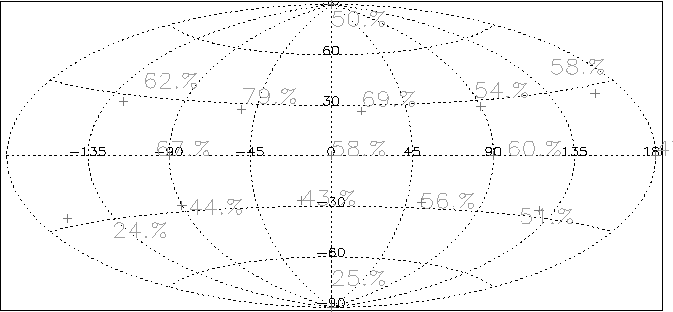![[*]](crossref.png) .
.
A given direction is considered to belong to the ![]() -th face, whenever
the mininum angular distance between the given direction and the normal
direction to the
-th face, whenever
the mininum angular distance between the given direction and the normal
direction to the ![]() -th face (
-th face (![]() or 12, depending on whether
the cube or the dodecahedron grid is considered, respectively), occurs when
or 12, depending on whether
the cube or the dodecahedron grid is considered, respectively), occurs when ![]() .
In the case of the cube grid,
the six cube faces, corresponding to the six sky regions, are so numbered:
face # 1 corresponds to GRBM unit 1, and so on till # 4 facing GRBM 4;
then face # 5 refers to the top face (pointing along the same direction
of the NFIs), while # 6 faces the opposite direction, i.e. the BeppoSAX
local south pole. For the dodecahedron faces, their local coordinates can
be read from table
.
In the case of the cube grid,
the six cube faces, corresponding to the six sky regions, are so numbered:
face # 1 corresponds to GRBM unit 1, and so on till # 4 facing GRBM 4;
then face # 5 refers to the top face (pointing along the same direction
of the NFIs), while # 6 faces the opposite direction, i.e. the BeppoSAX
local south pole. For the dodecahedron faces, their local coordinates can
be read from table ![[*]](crossref.png) .
.
In the following table ![[*]](crossref.png) the results are reported in two cases: first, by
taking into account only the BATSE 4B catalog; second, the three merged
catalogs: BATSE 4B, Kommers' and Stern's (4B+K+S, in the table).
Both the cube and the dodecahedron grid cases are reported; in the latter case,
only the merged catalogs have been considered, otherwise the statistics would
be poor.
the results are reported in two cases: first, by
taking into account only the BATSE 4B catalog; second, the three merged
catalogs: BATSE 4B, Kommers' and Stern's (4B+K+S, in the table).
Both the cube and the dodecahedron grid cases are reported; in the latter case,
only the merged catalogs have been considered, otherwise the statistics would
be poor.
| Local Sky | Det | Exp |
|
Det | Exp |
|
||
| Region | ( |
( |
(4B) | (4B) | (4B) | (4B+K+S) | (4B+K+S) | (4B+K+S) |
| (Cube) | ||||||||
| GRBM 1 | 270 | 0 | 55 | 65 | 75 | 112 | ||
| GRBM 2 | 0 | 0 | 59 | 75 | 75 | 129 | ||
| GRBM 3 | 90 | 0 | 43 | 58 | 62 | 103 | ||
| GRBM 4 | 180 | 0 | 34 | 51 | 43 | 92 | ||
| North Pole | 0 | +90 | 43 | 55 | 52 | 94 | ||
| South Pole | 0 | -90 | 28 | 84 | 32 | 132 | ||
| Total | - | - | 262 | 388 | 339 | 662 |
| Local Sky | Det | Exp |
|
||
| Region | ( |
( |
(4B+K+S) | (4B+K+S) | (4B+K+S) |
| (Dodecahedron) | |||||
| Face 1 | 0 | +90.00 | 24 | 48 | |
| Face 2 | 90 | +26.56 | 25 | 46 | |
| Face 3 | 162 | +26.56 | 26 | 45 | |
| Face 4 | 234 | +26.56 | 32 | 52 | |
| Face 5 | 306 | +26.56 | 54 | 68 | |
| Face 6 | 18 | +26.56 | 36 | 52 | |
| Face 7 | 0 | -90.00 | 17 | 67 | |
| Face 8 | 270 | -26.56 | 28 | 64 | |
| Face 9 | 342 | -26.56 | 26 | 60 | |
| Face 10 | 54 | -26.56 | 33 | 59 | |
| Face 11 | 126 | -26.56 | 26 | 51 | |
| Face 12 | 198 | -26.56 | 12 | 50 | |
| Total | - | - | 339 | 662 |
 |
![[*]](crossref.png) suggest some observations: the GRBM efficiency looks quite constant
within the uncertainties, except for the BeppoSAX local south pole, where
it falls down to
suggest some observations: the GRBM efficiency looks quite constant
within the uncertainties, except for the BeppoSAX local south pole, where
it falls down to ![[*]](crossref.png) ).
The average efficiency is
).
The average efficiency is
Finally, one might note that the number of BATSE 4B common bursts (262)
reported in table ![[*]](crossref.png) and
the number of total bursts, including the BATSE non-triggered catalogs
(339), are smaller than the corresponding numbers 283 and 283+79=362,
respectively, reported in tables
and
the number of total bursts, including the BATSE non-triggered catalogs
(339), are smaller than the corresponding numbers 283 and 283+79=362,
respectively, reported in tables ![[*]](crossref.png) and
and ![[*]](crossref.png) :
actually, some bursts happened when the BeppoSAX spacecraft attitude
was not known, during the time interval May - July 1997; hence,
for these GRBs, the transformation from celestial to local coordinates
was not feasible; owing to this, they have not been taken into
account for estimating the GRBM efficiency as a function of the local
direction.
:
actually, some bursts happened when the BeppoSAX spacecraft attitude
was not known, during the time interval May - July 1997; hence,
for these GRBs, the transformation from celestial to local coordinates
was not feasible; owing to this, they have not been taken into
account for estimating the GRBM efficiency as a function of the local
direction.